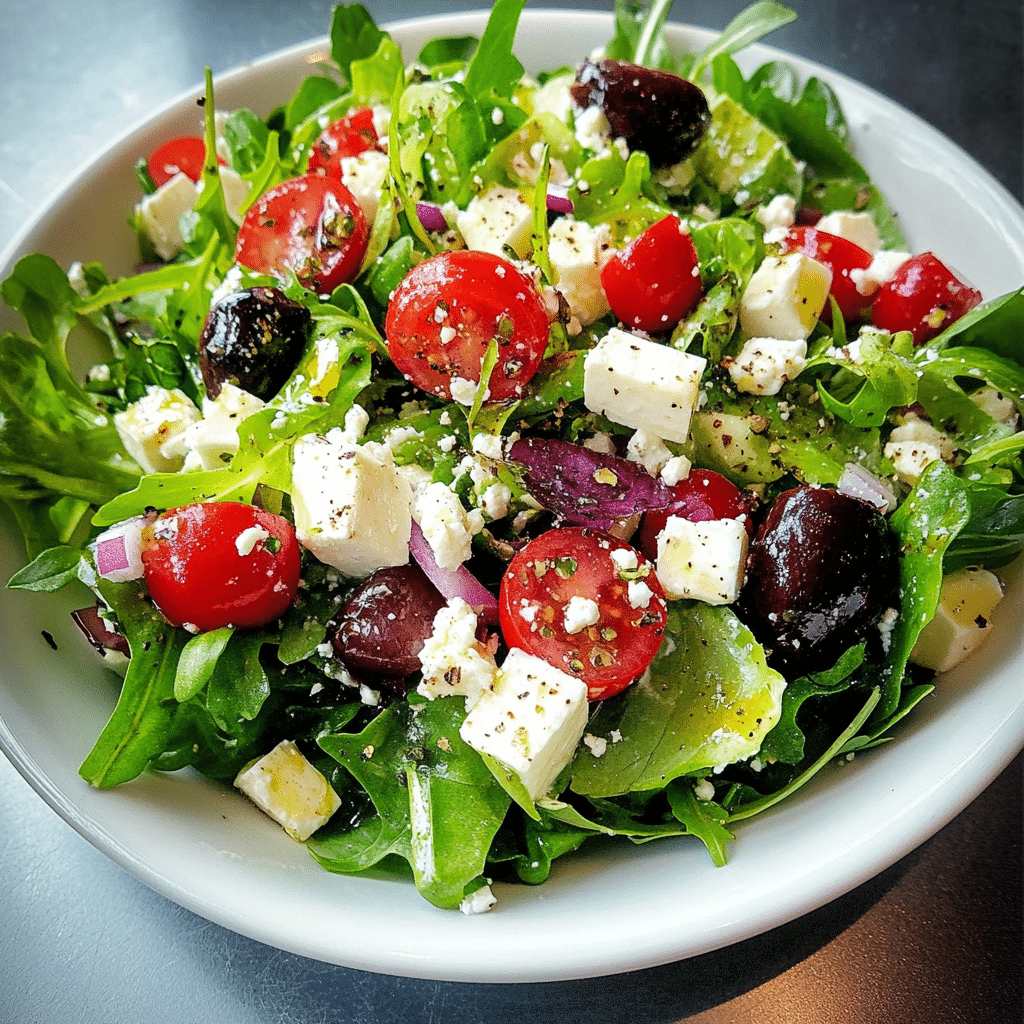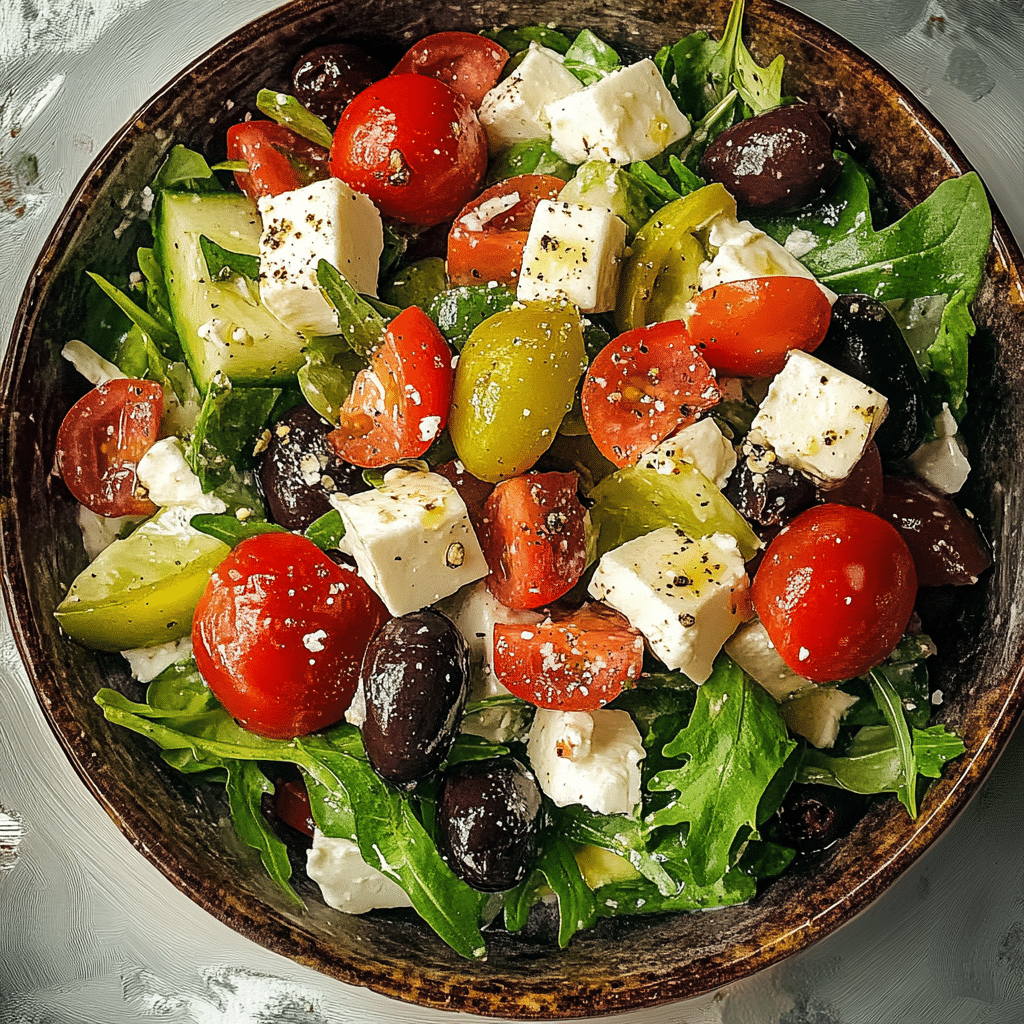Introduction
If you’re looking for a salad that’s not only refreshing and vibrant but also full of bold flavors and healthy ingredients, look no further than a Refreshing Greek Salad. Known for its simplicity and balance of fresh vegetables, salty feta cheese, briny olives, and zesty dressing, this Mediterranean classic is a must-try. It’s the perfect side dish for summer meals, a great lunch option, or a light dinner that doesn’t skimp on flavor.
Greek salad, or Horiatiki, is a celebration of the fresh, bright produce that grows in the Mediterranean region, along with the distinct flavors of olive oil, oregano, and lemon. This dish is the epitome of “less is more,” where high-quality ingredients shine through without overwhelming seasonings or complicated preparation methods. It’s a naturally gluten-free, vegetarian, and low-calorie option that still satisfies your taste buds and leaves you feeling refreshed and nourished.
In this article, we’ll dive into why Refreshing Greek Salad is such a beloved dish, walk you through a simple recipe that will have you making it again and again, and explore various ways you can customize it to suit your preferences. Whether you’re making it as a light lunch or as an accompaniment to grilled meats or seafood, this salad is sure to be a hit.
Why You’ll Love This Recipe
- Simple and Quick: With minimal prep time and no cooking required, this salad can be put together in just 15-20 minutes, making it the perfect go-to dish when you’re short on time but want something healthy and flavorful.
- Packed with Nutrients: Full of fresh vegetables like tomatoes, cucumbers, and red onions, this salad is loaded with vitamins and minerals. The addition of feta cheese provides a good source of protein and calcium, while olives offer healthy fats.
- Customizable: Greek salad is incredibly versatile. You can easily add or remove ingredients to suit your taste preferences, dietary restrictions, or the ingredients you have on hand.
- Naturally Gluten-Free and Vegetarian: This salad is ideal for those with dietary preferences or restrictions, as it’s naturally free from gluten and meat. Plus, it’s a fantastic choice for anyone looking for a lighter meal without sacrificing flavor.
- Perfect for Any Occasion: Whether you’re hosting a dinner party, prepping for a barbecue, or just need a quick weeknight meal, a Greek salad is always a crowd-pleaser. Its vibrant colors and fresh ingredients make it the perfect side dish for almost any occasion.
Preparation Time and Servings
- Total Time: 15 minutes (prep only)
- Servings: 4-6 servings
- Nutrition Facts (per serving): Calories: 150, Protein: 5g, Carbs: 10g, Fat: 12g.
Ingredients
For the Salad:
- 3 cups cucumber, diced: Cucumbers add a cool, refreshing crunch to the salad and provide a mild, hydrating element.
- 2 cups cherry or grape tomatoes, halved: Sweet, juicy tomatoes are a staple in Greek salad, offering a burst of flavor in every bite.
- 1 red onion, thinly sliced: Red onion provides a sharp, slightly sweet flavor that contrasts perfectly with the other ingredients.
- 1 cup Kalamata olives: Briny olives add depth and a salty kick that balances the sweetness of the vegetables.
- 1 cup green bell pepper, diced: Green peppers add a crunchy, slightly bitter flavor that pairs well with the other salad ingredients.
- 1 cup feta cheese, crumbled or in blocks: Feta is the quintessential ingredient in Greek salad, offering a creamy, tangy flavor that enhances the entire dish.
- 2 tablespoons fresh parsley, chopped: Fresh parsley adds a burst of color and a mild, herbaceous note that brightens up the salad.
- 1 tablespoon fresh oregano (or 1 teaspoon dried oregano): Oregano is the signature herb in Greek cuisine and adds an aromatic, earthy flavor to the salad.
For the Dressing:
- 3 tablespoons extra virgin olive oil: Olive oil is the heart of the dressing, providing a smooth, rich base.
- 2 tablespoons fresh lemon juice: The acidity of lemon juice cuts through the richness of the olive oil, adding brightness to the salad.
- 1 tablespoon red wine vinegar: Red wine vinegar enhances the tanginess and brings a slightly sharper acidity to the dressing.
- 1 teaspoon honey or agave syrup: A hint of sweetness balances the acidity of the lemon and vinegar.
- Salt and pepper: To taste, for seasoning the dressing and bringing out the full flavors of the salad.
- 1/2 teaspoon garlic powder: For a subtle depth of flavor that enhances the dressing without overpowering the fresh ingredients.
First Step: PREPARE THE VEGETABLES
- Chop the Vegetables: Begin by washing all the vegetables thoroughly. Slice the cucumber into half-moons or small cubes, depending on your preference. Halve the cherry tomatoes, and thinly slice the red onion. Dice the green bell pepper into small chunks.
- Prep the Olives: If you’re using whole Kalamata olives, slice them in half or leave them whole — your choice! Their briny, salty flavor will infuse the salad beautifully.
- Prepare the Feta Cheese: You can either crumble the feta into small pieces or cut it into large chunks, depending on how you like your cheese in the salad. Large blocks of feta give a more rustic feel, while crumbled feta spreads the tangy flavor throughout the dish.
- Chop the Fresh Herbs: Finely chop the fresh parsley and oregano. Fresh herbs really elevate this salad, making it even more fragrant and flavorful.
Second Step: MAKE THE DRESSING
- Whisk the Dressing Ingredients: In a small bowl or jar, combine the extra virgin olive oil, fresh lemon juice, red wine vinegar, honey, salt, pepper, and garlic powder. Whisk everything together until well combined. If you prefer a thicker dressing, you can blend the ingredients in a food processor or shake them in a jar until emulsified.
- Taste and Adjust: Taste the dressing and adjust the seasoning. If you prefer more acidity, add a little more lemon juice or vinegar. For sweetness, add a touch more honey or agave. You can also increase the garlic powder for a more robust flavor.
Third Step: ASSEMBLE THE SALAD
- Combine the Vegetables: In a large salad bowl, combine the chopped cucumber, cherry tomatoes, red onion, green bell pepper, and Kalamata olives. Toss them gently to mix the ingredients evenly.
- Add the Feta: Once the vegetables are mixed, add the crumbled or cubed feta cheese. Be gentle as you toss, as you don’t want to break the feta into too small pieces.
- Toss with the Dressing: Drizzle the prepared dressing over the salad. Toss everything together gently, making sure each ingredient is coated in the dressing.
- Garnish with Fresh Herbs: Sprinkle the chopped parsley and oregano over the top of the salad. These herbs will add color and freshness, making the salad look even more appetizing.
Fourth Step: SERVE AND ENJOY
- Serve Immediately: Greek salad is best served immediately to preserve the crunch and freshness of the vegetables. It pairs wonderfully with grilled meats, seafood, or can be served on its own as a light meal.
- Store Leftovers: If you have leftovers, store the salad in an airtight container in the fridge. However, keep in mind that the salad may become soggy after a few hours due to the dressing. To prevent this, store the dressing separately and add it just before serving.

How to Serve Refreshing Greek Salad
This Refreshing Greek Salad is a versatile dish that can be served in various ways. Here are some great options for serving it:
1. As a Light Main Dish
If you’re looking for a light, healthy meal, Greek salad can be served as a main course on its own. The combination of fresh vegetables, creamy feta, and briny olives is filling and satisfying, especially with the addition of olive oil and feta cheese.
2. Pair with Grilled Meats or Seafood
Greek salad is the perfect accompaniment to grilled meats like lamb, chicken, or pork. It also pairs beautifully with grilled fish or seafood, as the fresh and tangy salad complements the smoky, charred flavors of the grilled proteins.
3. Serve as a Side for Mediterranean Dishes
Serve this Greek salad alongside Mediterranean dishes such as hummus, falafel, pita bread, or roasted vegetables. It’s an excellent side for any Middle Eastern or Mediterranean-inspired meal.
4. Great for Potlucks or Parties
Greek salad is always a hit at potlucks or dinner parties. Its vibrant colors and refreshing taste make it a great dish to bring to gatherings, and it pairs well with a variety of main dishes.
Recipe Variations
While the classic Greek salad is fantastic as written, there are several ways to customize it to fit your preferences:
1. Add Protein
For a more substantial meal, you can add grilled chicken, shrimp, or even chickpeas for a plant-based protein. Adding protein makes the salad more filling and turns it into a complete meal.
2. Incorporate More Veggies
You can add other vegetables like cucumber ribbons, radishes, or even roasted bell peppers to give the salad an extra boost of color and flavor.
3. Make It Vegan
To make this salad vegan-friendly, skip the feta cheese and add a plant-based cheese alternative or simply enjoy it without cheese. The dressing, with its lemon and olive oil base, remains delicious without dairy.
4. Add Grains
For a heartier salad, you can add cooked quinoa, bulgur, or couscous. These grains add texture and make the salad even more filling, transforming it into a grain-based bowl.
Tips for Perfect Greek Salad
- Use Fresh Ingredients: The fresher the vegetables, the better your salad will taste. Try to use ripe tomatoes, firm cucumbers, and crisp greens to get the best flavor and texture.
- Don’t Overdress: Greek salad should be lightly dressed. Don’t drench it in dressing, as it will become soggy. A little goes a long way.
- Serve Immediately: Greek salad is best served fresh, so prepare it just before you plan to eat. If you need to prep ahead of time, store the dressing separately and toss everything together just before serving.
- Customize Your Feta: Experiment with different types of feta — there are variations that are creamier, crumblier, or more robust in flavor. Find the one that suits your taste!

Refreshing Greek Salad: A Light, Flavorful, and Nutrient-Packed Dish
- Total Time: 15 minutes
Description
A classic Greek salad with a twist of freshness! Crisp cucumbers, juicy tomatoes, red onion, Kalamata olives, and creamy feta cheese are tossed together in a simple yet flavorful lemon-oregano dressing. This Mediterranean salad is light, healthy, and perfect as a side dish or a light lunch. The tangy flavors and crunchy vegetables make it a refreshing choice for any meal.
Ingredients
For the Salad:
- 3 cups cucumber, diced: Cucumbers add a cool, refreshing crunch to the salad and provide a mild, hydrating element.
- 2 cups cherry or grape tomatoes, halved: Sweet, juicy tomatoes are a staple in Greek salad, offering a burst of flavor in every bite.
- 1 red onion, thinly sliced: Red onion provides a sharp, slightly sweet flavor that contrasts perfectly with the other ingredients.
- 1 cup Kalamata olives: Briny olives add depth and a salty kick that balances the sweetness of the vegetables.
- 1 cup green bell pepper, diced: Green peppers add a crunchy, slightly bitter flavor that pairs well with the other salad ingredients.
- 1 cup feta cheese, crumbled or in blocks: Feta is the quintessential ingredient in Greek salad, offering a creamy, tangy flavor that enhances the entire dish.
- 2 tablespoons fresh parsley, chopped: Fresh parsley adds a burst of color and a mild, herbaceous note that brightens up the salad.
- 1 tablespoon fresh oregano (or 1 teaspoon dried oregano): Oregano is the signature herb in Greek cuisine and adds an aromatic, earthy flavor to the salad.
For the Dressing:
- 3 tablespoons extra virgin olive oil: Olive oil is the heart of the dressing, providing a smooth, rich base.
- 2 tablespoons fresh lemon juice: The acidity of lemon juice cuts through the richness of the olive oil, adding brightness to the salad.
- 1 tablespoon red wine vinegar: Red wine vinegar enhances the tanginess and brings a slightly sharper acidity to the dressing.
- 1 teaspoon honey or agave syrup: A hint of sweetness balances the acidity of the lemon and vinegar.
- Salt and pepper: To taste, for seasoning the dressing and bringing out the full flavors of the salad.
- 1/2 teaspoon garlic powder: For a subtle depth of flavor that enhances the dressing without overpowering the fresh ingredients.
Instructions
First Step: PREPARE THE VEGETABLES
- Chop the Vegetables: Begin by washing all the vegetables thoroughly. Slice the cucumber into half-moons or small cubes, depending on your preference. Halve the cherry tomatoes, and thinly slice the red onion. Dice the green bell pepper into small chunks.
- Prep the Olives: If you’re using whole Kalamata olives, slice them in half or leave them whole — your choice! Their briny, salty flavor will infuse the salad beautifully.
- Prepare the Feta Cheese: You can either crumble the feta into small pieces or cut it into large chunks, depending on how you like your cheese in the salad. Large blocks of feta give a more rustic feel, while crumbled feta spreads the tangy flavor throughout the dish.
- Chop the Fresh Herbs: Finely chop the fresh parsley and oregano. Fresh herbs really elevate this salad, making it even more fragrant and flavorful.
Second Step: MAKE THE DRESSING
- Whisk the Dressing Ingredients: In a small bowl or jar, combine the extra virgin olive oil, fresh lemon juice, red wine vinegar, honey, salt, pepper, and garlic powder. Whisk everything together until well combined. If you prefer a thicker dressing, you can blend the ingredients in a food processor or shake them in a jar until emulsified.
- Taste and Adjust: Taste the dressing and adjust the seasoning. If you prefer more acidity, add a little more lemon juice or vinegar. For sweetness, add a touch more honey or agave. You can also increase the garlic powder for a more robust flavor.
Third Step: ASSEMBLE THE SALAD
- Combine the Vegetables: In a large salad bowl, combine the chopped cucumber, cherry tomatoes, red onion, green bell pepper, and Kalamata olives. Toss them gently to mix the ingredients evenly.
- Add the Feta: Once the vegetables are mixed, add the crumbled or cubed feta cheese. Be gentle as you toss, as you don’t want to break the feta into too small pieces.
- Toss with the Dressing: Drizzle the prepared dressing over the salad. Toss everything together gently, making sure each ingredient is coated in the dressing.
- Garnish with Fresh Herbs: Sprinkle the chopped parsley and oregano over the top of the salad. These herbs will add color and freshness, making the salad look even more appetizing.
Fourth Step: SERVE AND ENJOY
- Serve Immediately: Greek salad is best served immediately to preserve the crunch and freshness of the vegetables. It pairs wonderfully with grilled meats, seafood, or can be served on its own as a light meal.
- Store Leftovers: If you have leftovers, store the salad in an airtight container in the fridge. However, keep in mind that the salad may become soggy after a few hours due to the dressing. To prevent this, store the dressing separately and add it just before serving.
- Prep Time: 15 minutes
Nutrition
- Calories: 150 kcal
- Fat: 12g
- Carbohydrates: 10g
- Protein: 5g
Conclusion
The Refreshing Greek Salad is a simple, delicious, and healthy dish that brings together the best flavors of the Mediterranean in one vibrant bowl. Its combination of fresh vegetables, briny olives, tangy feta, and zesty dressing makes it a satisfying and nutritious option for any meal.
Its versatility, ease of preparation, and customizable ingredients make it a go-to recipe for busy weeknights, potlucks, and summer gatherings. With the flavors of Greece in every bite, you’ll find yourself returning to this salad again and again. Give it a try today and enjoy the refreshing tastes of the Mediterranean!









